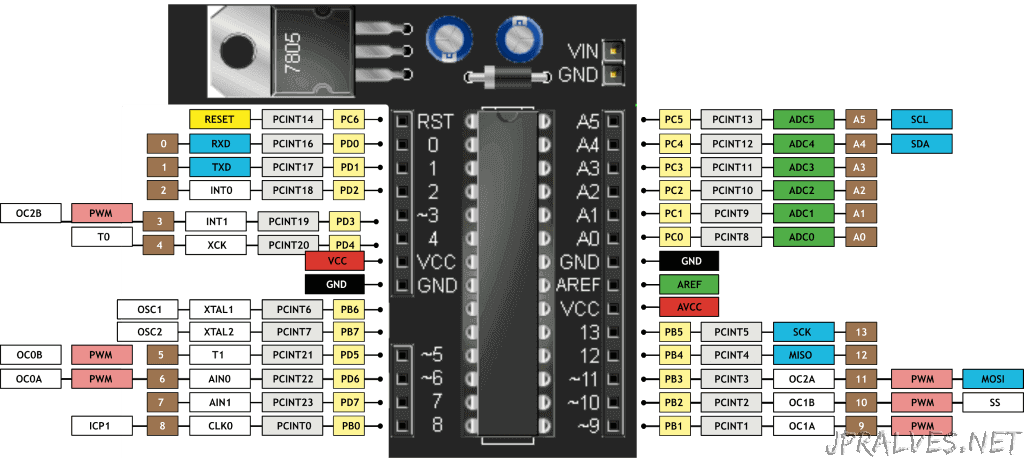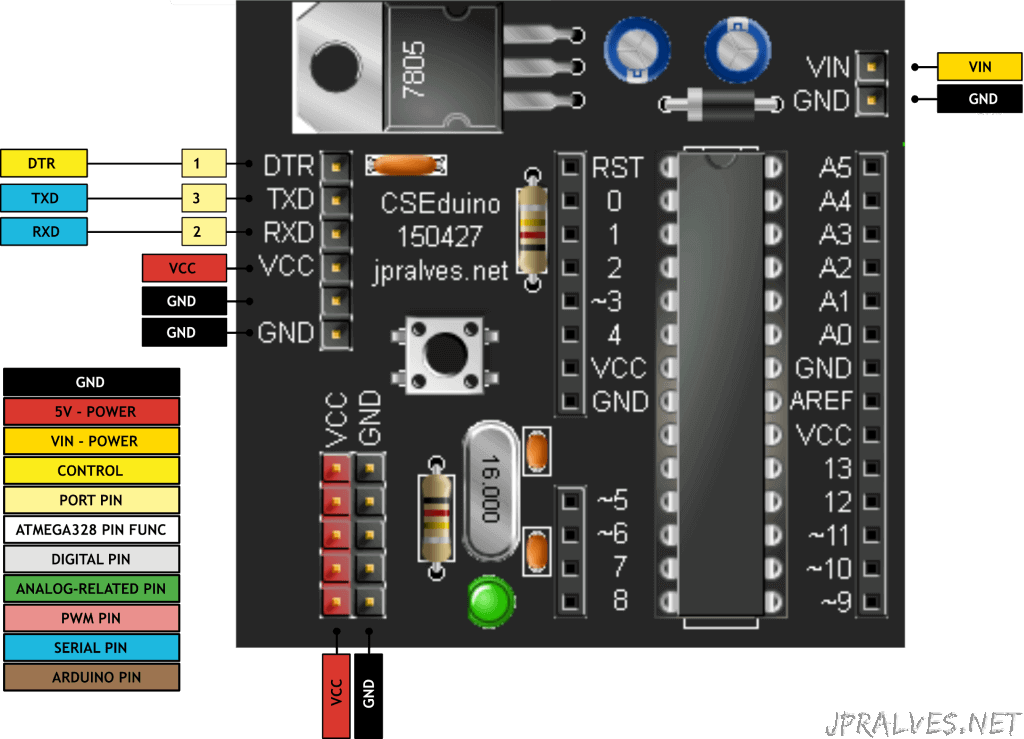
Arduino is an open-source computer hardware and software company, project and user community that designs and manufactures microcontroller-based kits for building digital devices and interactive objects that can sense and control objects in the physical world.
Uno
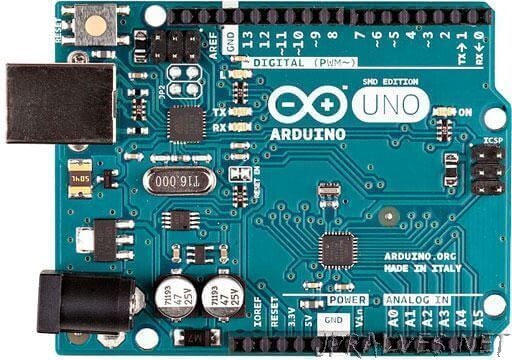
Arduino/Genuino Uno is a microcontroller board based on the ATmega328P (datasheet). It has 14 digital input/output pins (of which 6 can be used as PWM outputs), 6 analog inputs, a 16 MHz quartz crystal, a USB connection, a power jack, an ICSP header and a reset button. It contains everything needed to support the microcontroller; simply connect it to a computer with a USB cable or power it with a AC-to-DC adapter or battery to get started.. You can tinker with your UNO without worrying too much about doing something wrong, worst case scenario you can replace the chip for a few dollars and start over again.
“Uno” means one in Italian and was chosen to mark the release of Arduino Software (IDE) 1.0. The Uno board and version 1.0 of Arduino Software (IDE) were the reference versions of Arduino, now evolved to newer releases. The Uno board is the first in a series of USB Arduino boards, and the reference model for the Arduino platform; for an extensive list of current, past or outdated boards see the Arduino index of boards.
Specifications
- Microcontroller: ATmega328P
- Operating Voltage: 5V
- Input Voltage (recommended): 7-12V
- Input Voltage (limit): 6-20V
- Digital I/O Pins: 14 (of which 6 provide PWM output)
- PWM Digital I/O Pins: 6
- Analog Input Pins: 6
- DC Current per I/O Pin: 20 mA
- DC Current for 3.3V Pin: 50 mA
- Flash Memory: 32 KB (ATmega328P) - of which 0.5 KB used by bootloader
- SRAM: 2 KB (ATmega328P)
- EEPROM: 1 KB (ATmega328P)
- Clock Speed: 16 MHz
- LED_BUILTIN: 13
- Length: 68.6 mm
- Width: 53.4 mm
- Weight: 25 g
PinOut
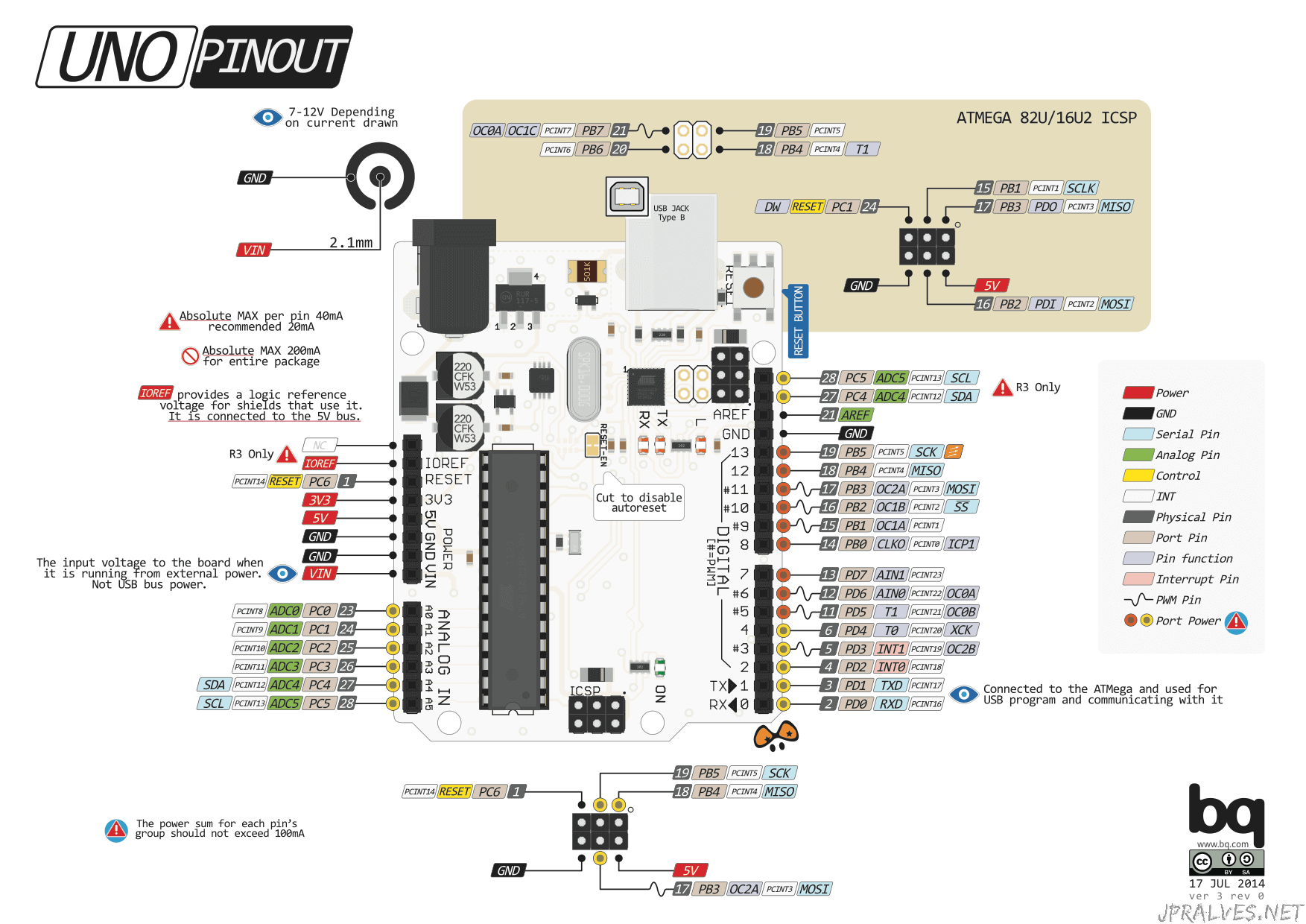
Dimensions
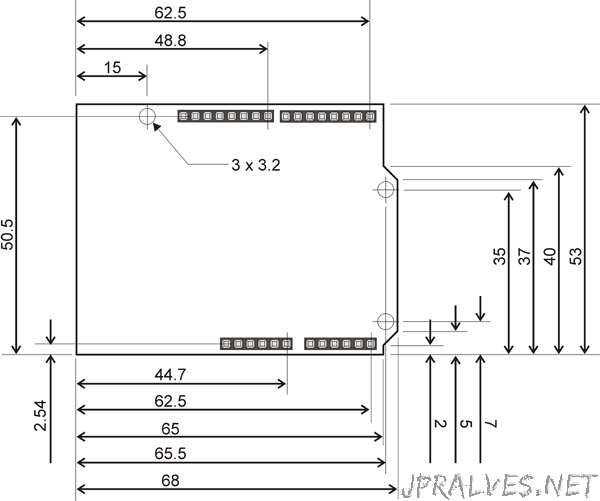
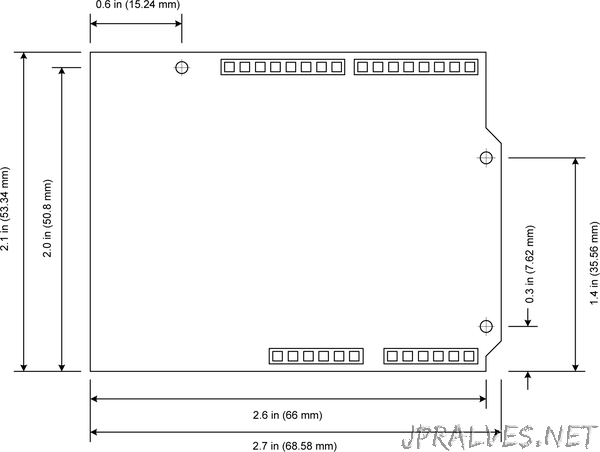
Mega 2560
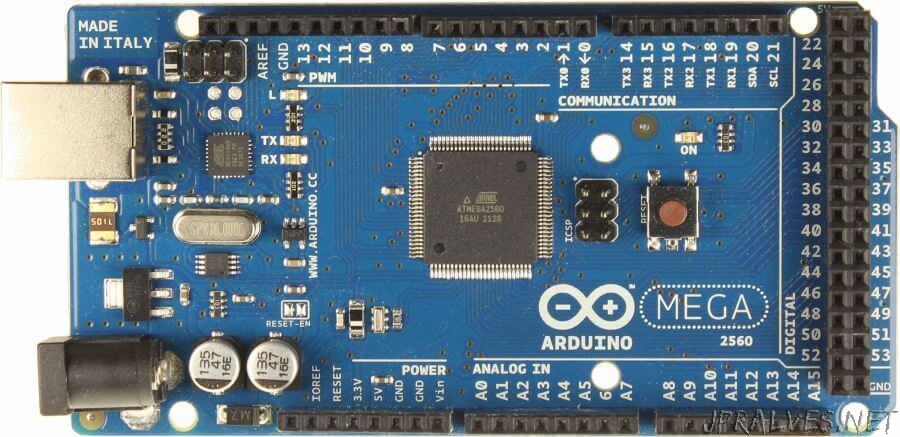
The Mega 2560 is a microcontroller board based on the ATmega2560. It has 54 digital input/output pins (of which 15 can be used as PWM outputs), 16 analog inputs, 4 UARTs (hardware serial ports), a 16 MHz crystal oscillator, a USB connection, a power jack, an ICSP header, and a reset button. It contains everything needed to support the microcontroller; simply connect it to a computer with a USB cable or power it with a AC-to-DC adapter or battery to get started. The Mega 2560 board is compatible with most shields designed for the Uno and the former boards Duemilanove or Diecimila.
Specifications
- Microcontroller: ATmega2560
- Operating Voltage: 5V
- Input Voltage (recommended): 7-12V
- Input Voltage (limit): 6-20V
- Digital I/O Pins: 54 (of which 15 provide PWM output)
- Analog Input Pins: 16
- DC Current per I/O Pin: 20 mA
- DC Current for 3.3V Pin: 50 mA
- Flash Memory: 256 KB of which 8 KB used by bootloader
- SRAM: 8 KB
- EEPROM: 4 KB
- Clock Speed: 16 MHz
- LED_BUILTIN: 13
- Length: 101.52 mm
- Width: 53.3 mm
- Weight: 37 g
PinOut
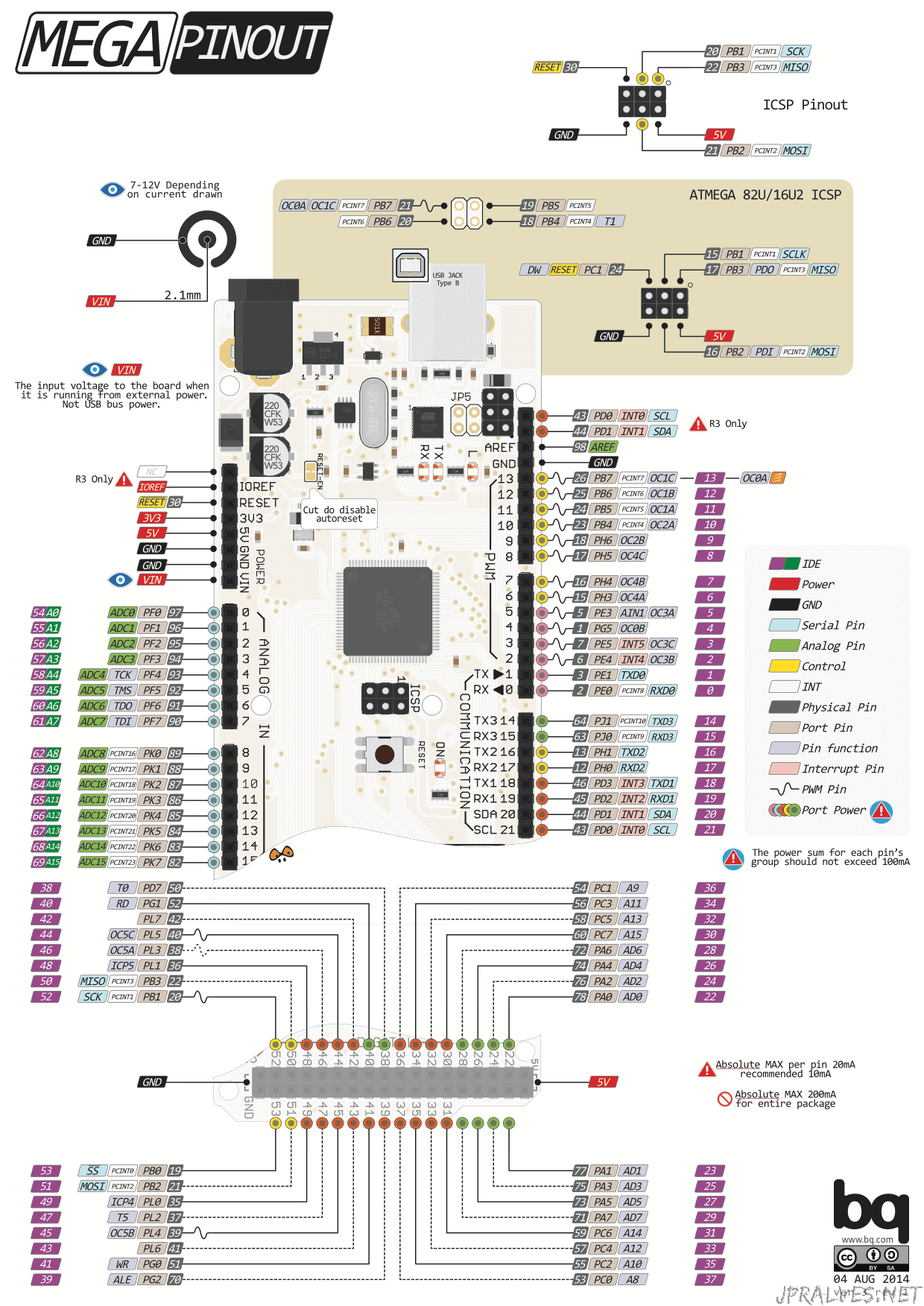
Dimensions
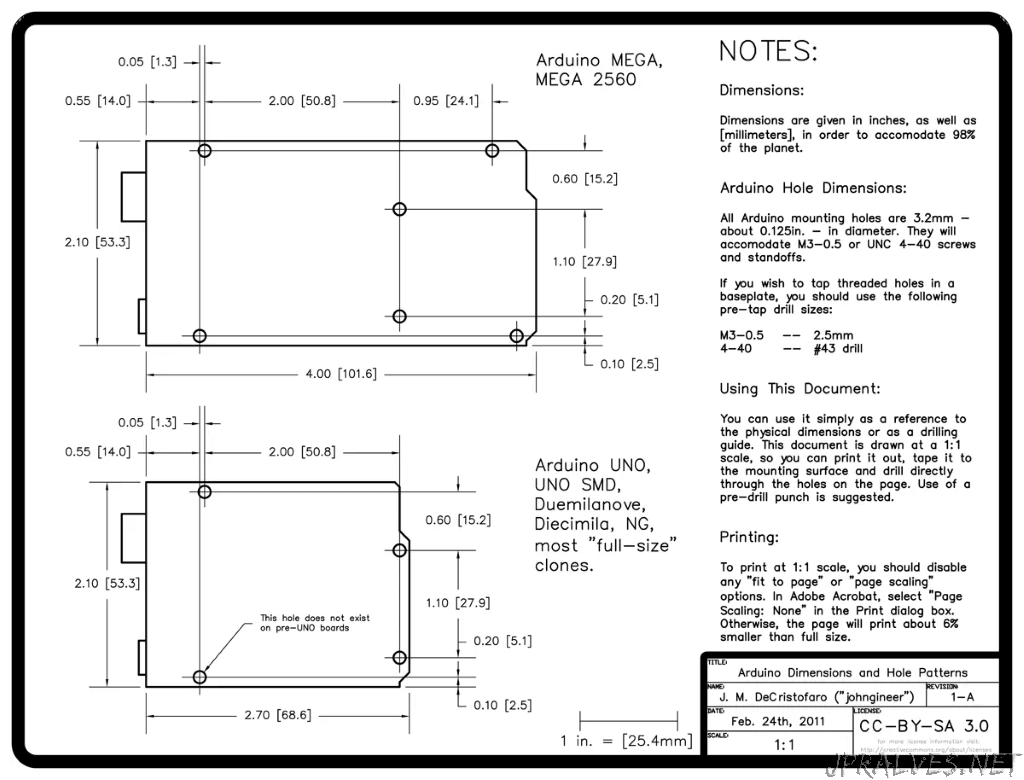
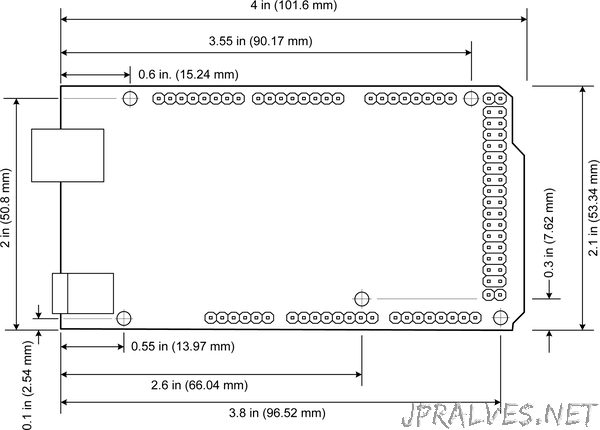
Pro Mini
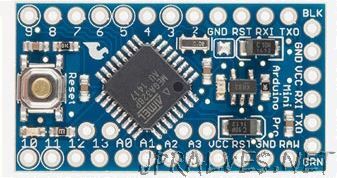
The Arduino Pro Mini is a microcontroller board based on the ATmega328. It has 14 digital input/output pins (of which 6 can be used as PWM outputs), 6 analog inputs, an on-board resonator, a reset button, and holes for mounting pin headers. A six pin header can be connected to an FTDI cable or Sparkfun breakout board to provide USB power and communication to the board.The Arduino Pro Mini is intended for semi-permanent installation in objects or exhibitions. The board comes without pre-mounted headers, allowing the use of various types of connectors or direct soldering of wires. The pin layout is compatible with the Arduino Mini. There are two version of the Pro Mini. One runs at 3.3V and 8 MHz, the other at 5V and 16 MHz. The Arduino Pro Mini was designed and is manufactured by SparkFun Electronics.
Specifications
- Microcontroller: ATmega328 *
- Board Power Supply: 3.35 -12 V (3.3V model) or 5 - 12V (5V model)
- Circuit Operating Voltage: 3.3V or 5V (depending on model)
- Digital I/O Pins: 14
- PWM Pins: 6
- UART: 1
- SPI: 1
- I2C: 1
- Analog Input Pins: 6
- External Interrupts: 2
- DC Current per I/O Pin: 40 mA
- Flash Memory: 32KB of which 2 KB used by bootloader *
- SRAM: 2 KB *
- EEPROM: 1 KB *
- Clock Speed: 8 MHz (3.3V versions) or 16 MHz (5V versions)
PinOut
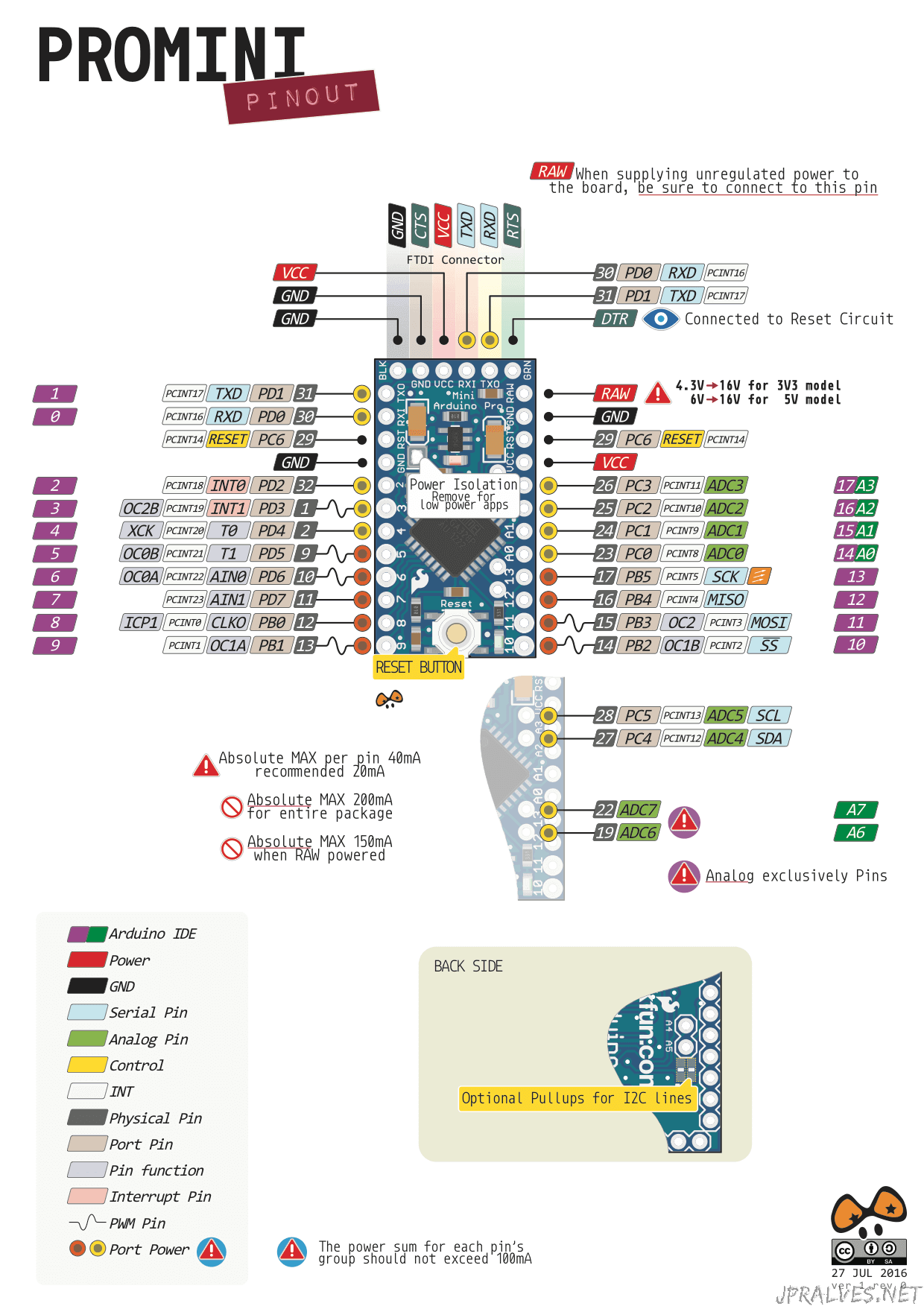

Dimensions
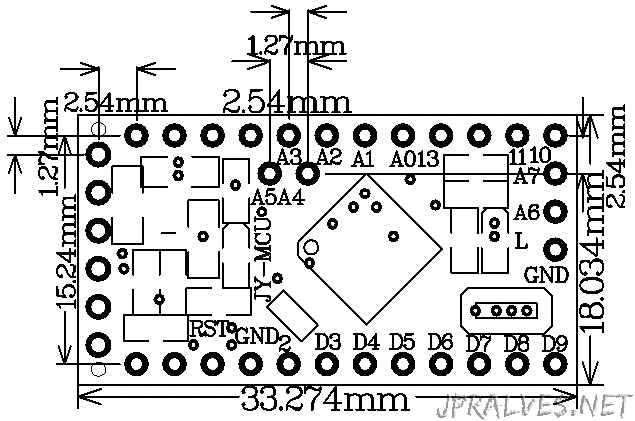
Yún
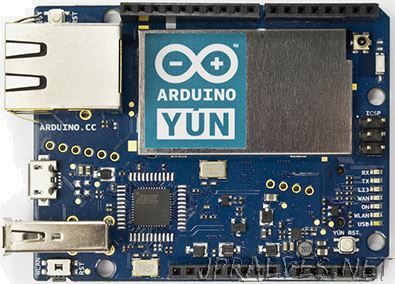
The Arduino Yún is a microcontroller board based on the ATmega32u4 and the Atheros AR9331. The Atheros processor supports a Linux distribution based on OpenWrt named OpenWrt-Yun. The board has built-in Ethernet and WiFi support, a USB-A port, micro-SD card slot, 20 digital input/output pins (of which 7 can be used as PWM outputs and 12 as analog inputs), a 16 MHz crystal oscillator, a micro USB connection, an ICSP header, and a 3 reset buttons.
Specifications
- AVR Arduino microcontroller
- Microcontroller: ATmega32U4
- Operating Voltage: 5V
- Input Voltage: 5
- Digital I/O Pins: 20
- PWM Channels: 7
- Analog Input Pins: 12
- DC Current per I/O Pin: 40 mA
- DC Current for 3.3V Pin: 50 mA
- Flash Memory: 32 KB (of which 4 KB used by bootloader)
- SRAM: 2.5 KB
- EEPROM: 1 KB
- Clock Speed: 16 MHz
- Processor: Atheros AR9331 (Linux Microprocessor)
- Architecture: MIPS @400MHz
- Operating Voltage: 3.3V
- Ethernet: IEEE 802.3 10/100Mbit/s
- WiFi: IEEE 802.11b/g/n
- USB Type-A: 2.0 Host
- Card Reader: Micro-SD only
- RAM: 64 MB DDR2
- Flash Memory: 16 MB
- SRAM: 2.5 KB
- EEPROM: 1 KB
- Clock Speed: 16 MHz
- PoE compatible 802.3af card support: See Power
PinOut
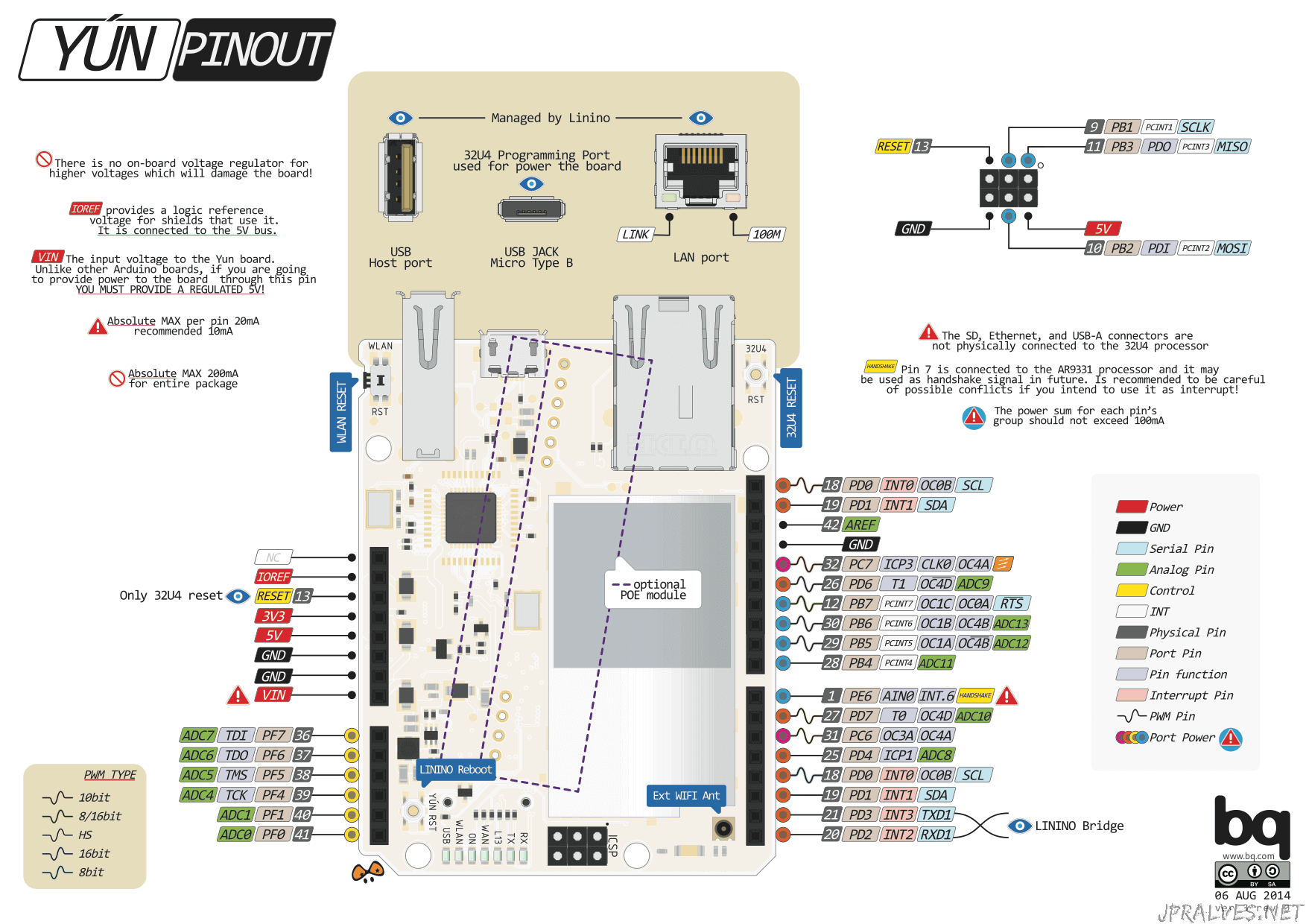
Nano
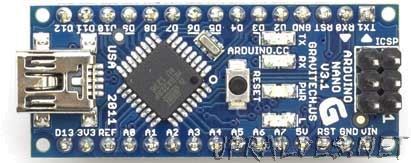
The Arduino Nano is a small, complete, and breadboard-friendly board based on the ATmega328 (Arduino Nano 3.x) or ATmega168 (Arduino Nano 2.x). It has more or less the same functionality of the Arduino Duemilanove, but in a different package. It lacks only a DC power jack, and works with a Mini-B USB cable instead of a standard one. The Nano was designed and is being produced by Gravitech.
Specifications
- Microcontroller: Atmel ATmega168 or ATmega328
- Operating Voltage (logic level): 5 V
- Input Voltage (recommended): 7-12 V
- Input Voltage (limits): 6-20 V
- Digital I/O Pins: 14 (of which 6 provide PWM output)
- Analog Input Pins: 8
- DC Current per I/O Pin: 40 mA
- Flash Memory: 16 KB (ATmega168) or 32 KB (ATmega328) of which 2 KB used by bootloader
- SRAM: 1 KB (ATmega168) or 2 KB (ATmega328)
- EEPROM: 512 bytes (ATmega168) or 1 KB (ATmega328)
- Clock Speed: 16 MHz
- Dimensions: 0.73” x 1.70”
- Length: 45 mm
- Width: 18 mm
PinOut

Dimensions
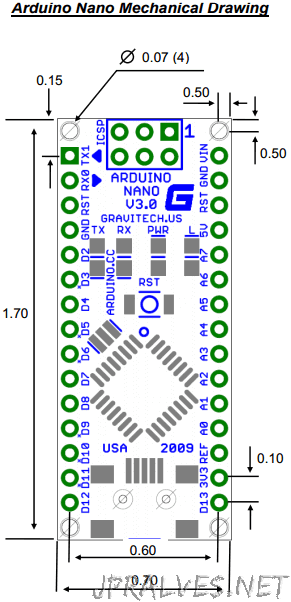

Leonardo
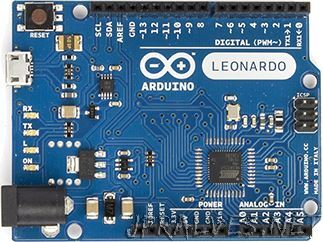
The Arduino Leonardo is a microcontroller board based on the ATmega32u4 (datasheet). It has 20 digital input/output pins (of which 7 can be used as PWM outputs and 12 as analog inputs), a 16 MHz crystal oscillator, a micro USB connection, a power jack, an ICSP header, and a reset button. It contains everything needed to support the microcontroller; simply connect it to a computer with a USB cable or power it with a AC-to-DC adapter or battery to get started.The Leonardo differs from all preceding boards in that the ATmega32u4 has built-in USB communication, eliminating the need for a secondary processor. This allows the Leonardo to appear to a connected computer as a mouse and keyboard, in addition to a virtual (CDC) serial / COM port. It also has other implications for the behavior of the board; these are detailed on the getting started page.
Specifications
- Microcontroller: ATmega32u4
- Operating Voltage: 5V
- Input Voltage (recommended): 7-12V
- Input Voltage (limits): 6-20V
- Digital I/O Pins: 20
- PWM Channels: 7
- Analog Input Channels: 12
- DC Current per I/O Pin: 40 mA
- DC Current for 3.3V Pin: 50 mA
- Flash Memory: 32 KB (ATmega32u4) of which 4 KB used by bootloader
- SRAM: 2.5 KB (ATmega32u4)
- EEPROM: 1 KB (ATmega32u4)
- Clock Speed: 16 MHz
- Length: 68.6 mm
- Width: 53.3 mm
- Weight: 20g
PinOut
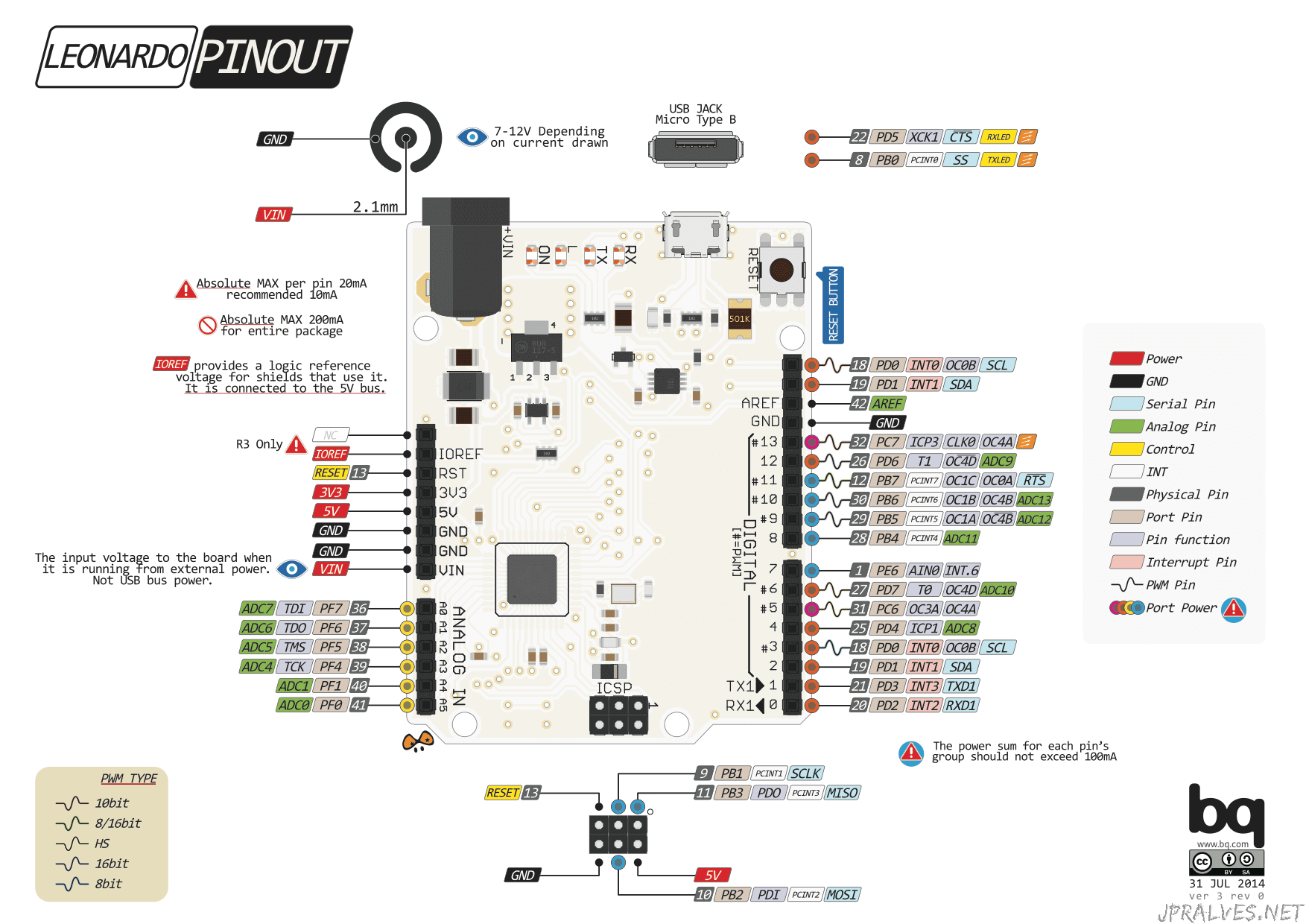
Due
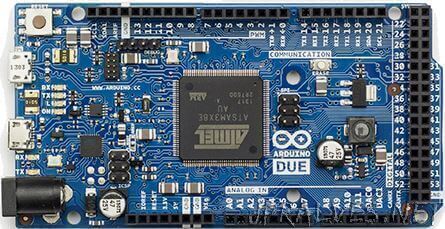
The Arduino Due is a microcontroller board based on the Atmel SAM3X8E ARM Cortex-M3 CPU. It is the first Arduino board based on a 32-bit ARM core microcontroller. It has 54 digital input/output pins (of which 12 can be used as PWM outputs), 12 analog inputs, 4 UARTs (hardware serial ports), a 84 MHz clock, an USB OTG capable connection, 2 DAC (digital to analog), 2 TWI, a power jack, an SPI header, a JTAG header, a reset button and an erase button.
Specifications
- Microcontroller: AT91SAM3X8E
- Operating Voltage: 3.3V
- Input Voltage (recommended): 7-12V
- Input Voltage (limits): 6-16V
- Digital I/O Pins: 54 (of which 12 provide PWM output)
- Analog Input Pins: 12
- Analog Output Pins: 2 (DAC)
- Total DC Output Current on all I/O lines: 130 mA
- DC Current for 3.3V Pin: 800 mA
- DC Current for 5V Pin: 800 mA
- Flash Memory: 512 KB all available for the user applications
- SRAM: 96 KB (two banks: 64KB and 32KB)
- Clock Speed: 84 MHz
- Length: 101.52 mm
- Width: 53.3 mm
- Weight: 36g
PinOut
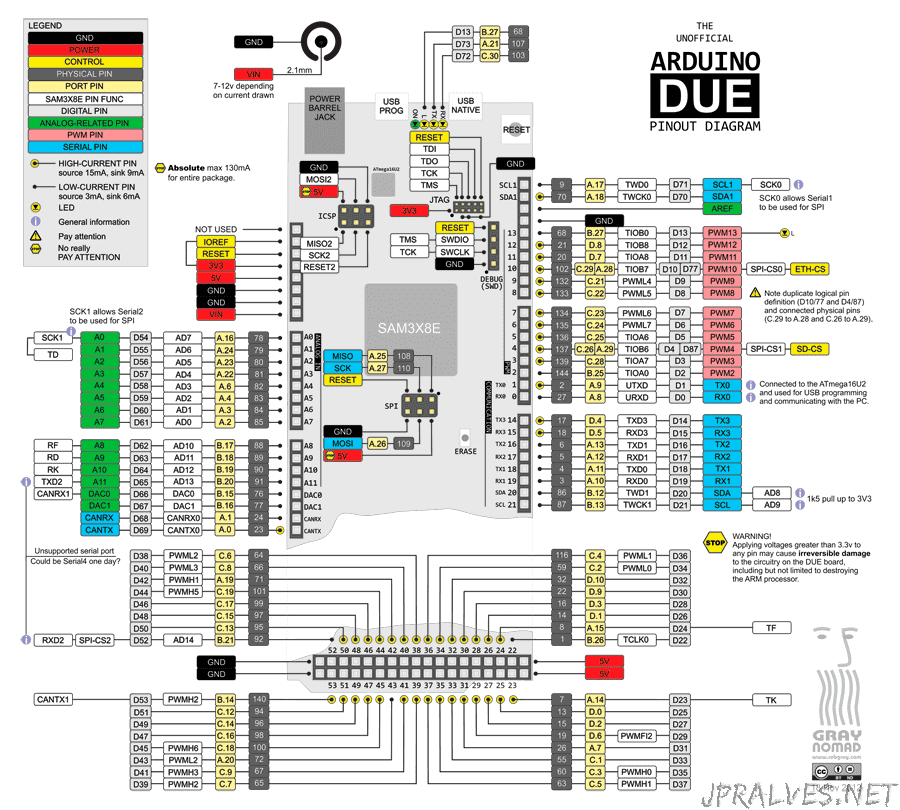
Lilypad
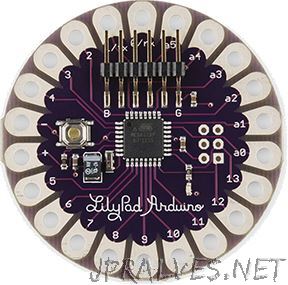
The LilyPad Arduino Main Board is based on the ATmega168V (the low-power version of the ATmega168) or the ATmega328V. The LilyPad Arduino was designed and developed by Leah Buechley and SparkFun Electronics.
Specifications
- Microcontroller: ATmega168 or ATmega328V
- Operating Voltage: 2.7-5.5 V
- Input Voltage: 2.7-5.5 V
- Digital I/O Pins: 14
- PWM Channels: 6
- Analog Input Channels: 6
- DC Current per I/O Pin: 40 mA
- Flash Memory: 16 KB (of which 2 KB used by bootloader)
- SRAM: 1 KB
- EEPROM: 512 bytes
- Clock Speed: 8 MHz
PinOut
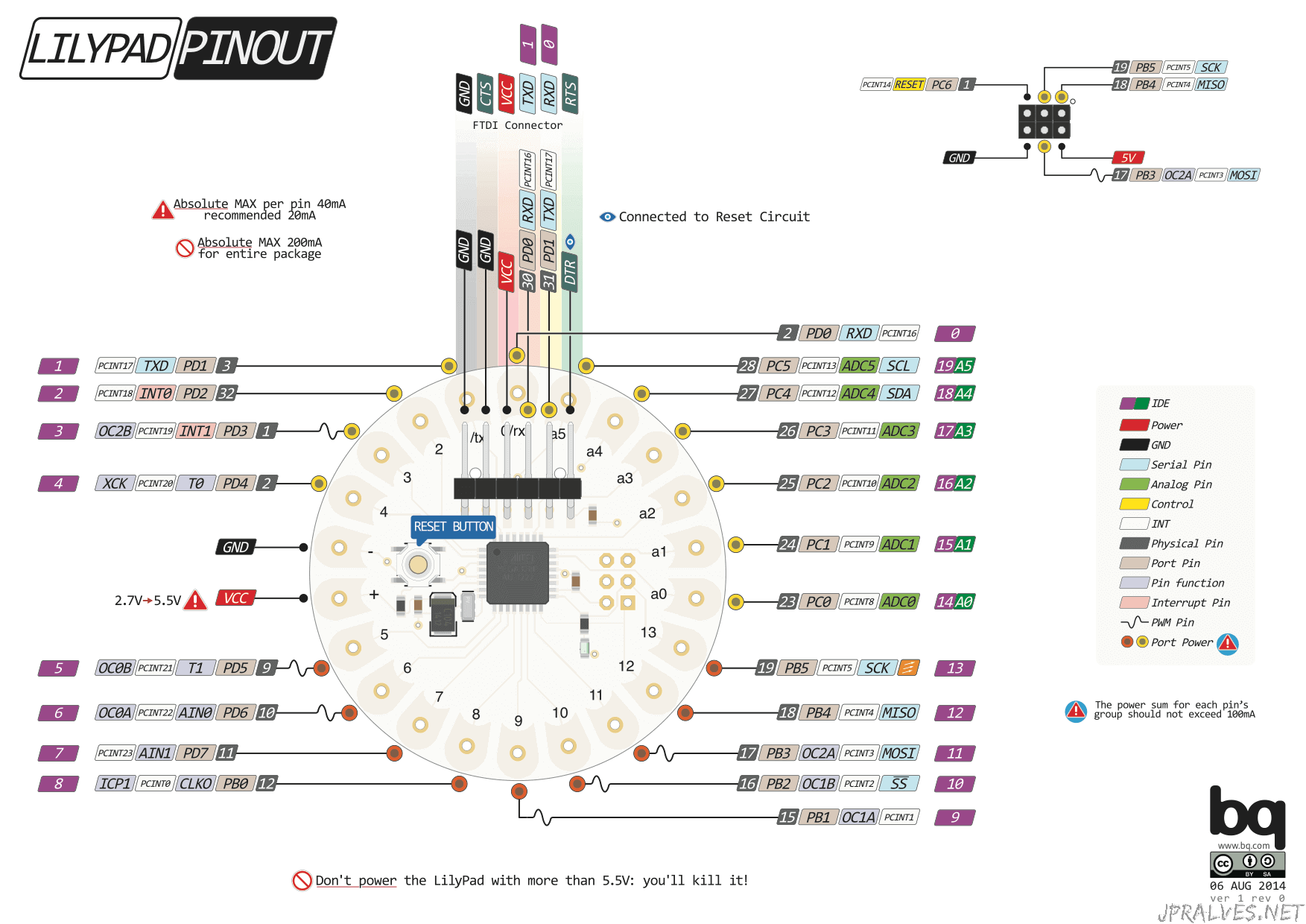
Dimensions
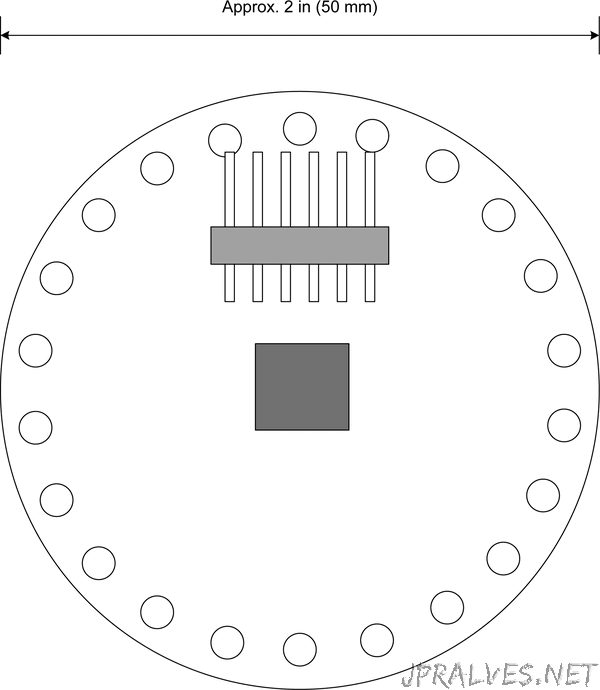
MEGA ADK

The Arduino MEGA ADK is a microcontroller board based on the ATmega2560 (datasheet). It has a USB host interface to connect with Android based phones, based on the MAX3421e IC. It has 54 digital input/output pins (of which 15 can be used as PWM outputs), 16 analog inputs, 4 UARTs (hardware serial ports), a 16 MHz crystal oscillator, a USB connection, a power jack, an ICSP header, and a reset button.
Specifications
- Microcontroller: ATmega2560
- Operating Voltage: 5V
- Input Voltage (recommended): 7-12V
- Input Voltage (limits): 6-20V
- Digital I/O Pins: 54 (of which 15 provide PWM output)
- Analog Input Pins: 16
- DC Current per I/O Pin: 40 mA
- DC Current for 3.3V Pin: 50 mA
- Flash Memory: 256 KB of which 8 KB used by bootloader
- SRAM: 8 KB
- EEPROM: 4 KB
- Clock Speed: 16 MHz
- USB Host Chip: MAX3421E
- Length: 101.52 mm
- Width: 53.3 mm
- Weight: 36g
CJMCU-LilyTiny LilyPad
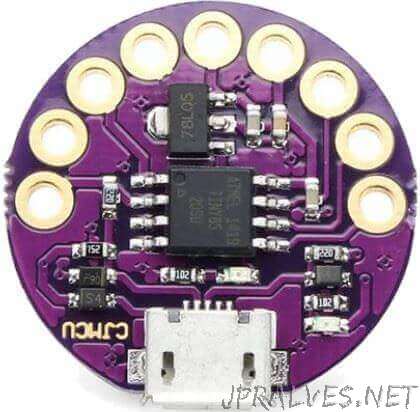
Specifications
- Micro MCU:ATTINY85
- Wearable
- 8K Byte of In-System Programmable Program Memory Flash
- 512 Bytes In-System Programmable EEPROM
- 512 Bytes Internal SRAM
- Diameter:25mm
- Support SPI/TWI communication
- 1.8~5.5V work voltage
Lilypad Arduino USB - ATMEGA32U4 Board
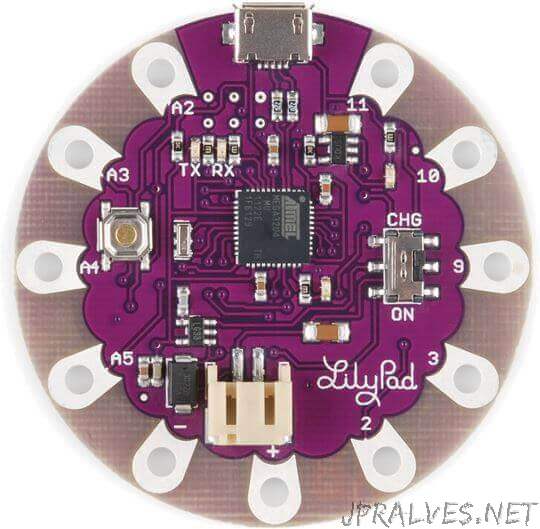
The LilyPad Arduino USB is a microcontroller board based on the ATmega32u4. It has 9 digital input/output pins (of which 4 can be used as PWM outputs and 4 as analog inputs), an 8 MHz resonator, a micro USB connection, a JST connector for a 3.7V LiPo battery, and a reset button. It contains everything needed to support the microcontroller; simply connect it to a computer with a USB cable or power it with a battery to get started. The LilyPad Arduino USB differs from previous LilyPad boards in that the ATmega32u4 has built-in USB communication, eliminating the need for a separate USB-to-serial adapter. This allows the LilyPad Arduino USB to appear to a connected computer as a mouse and keyboard, in addition to a virtual (CDC) serial / COM port.
Specifications
- Microcontroller ATmega32u4
- Operating Voltage 3.3V
- Input Voltage 3.8V to 5V
- Digital I/O Pins 9
- PWM Channels 4
- Analog Input Channels 4
- DC Current per I/O Pin 40 mA
- Flash Memory 32 KB (ATmega32u4) of which 4 KB used by bootloader S
- RAM 2.5 KB (ATmega32u4)
- EEPROM 1 KB (ATmega32u4)
- Clock Speed 8 MHz
PinOut
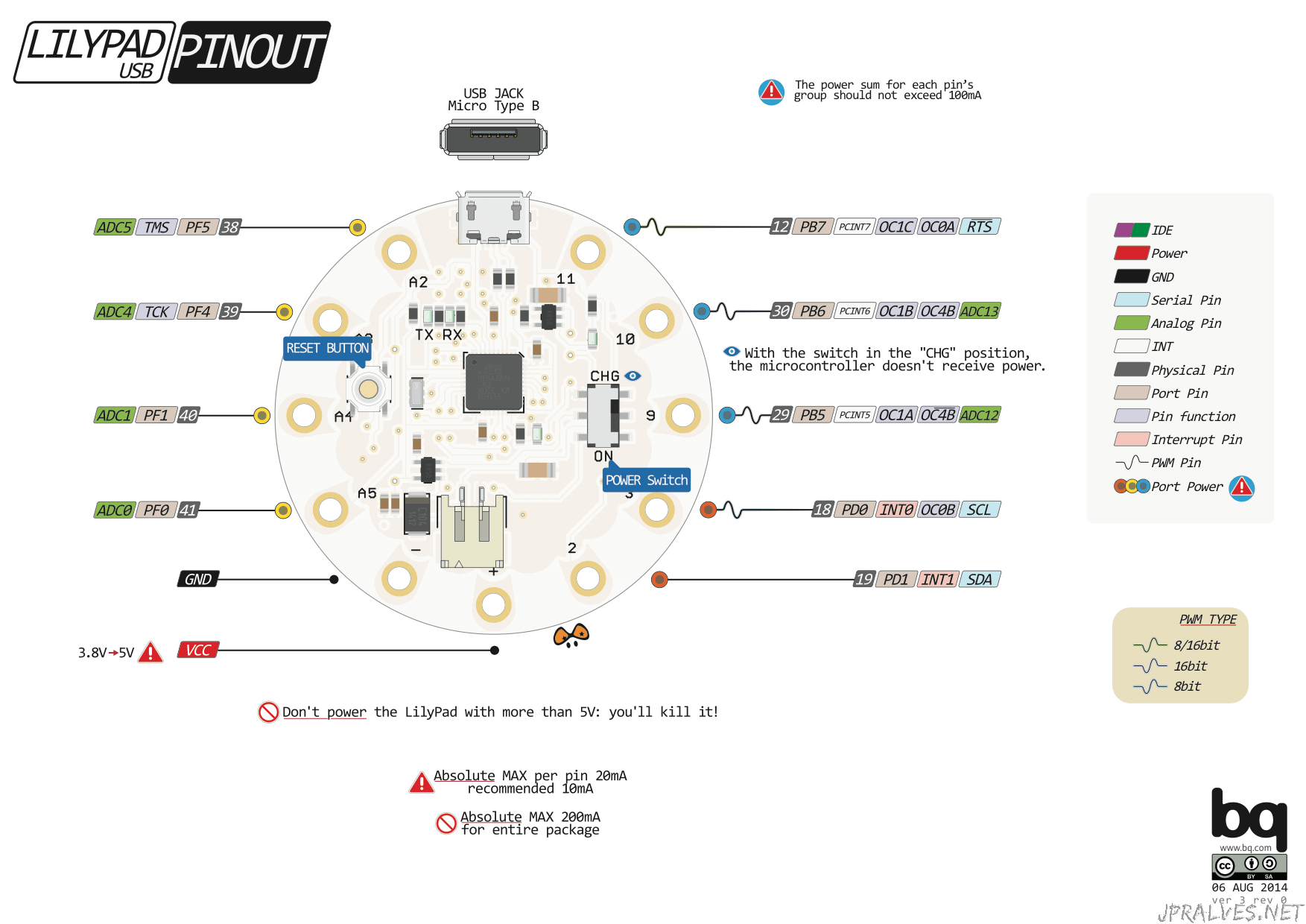
Esplora
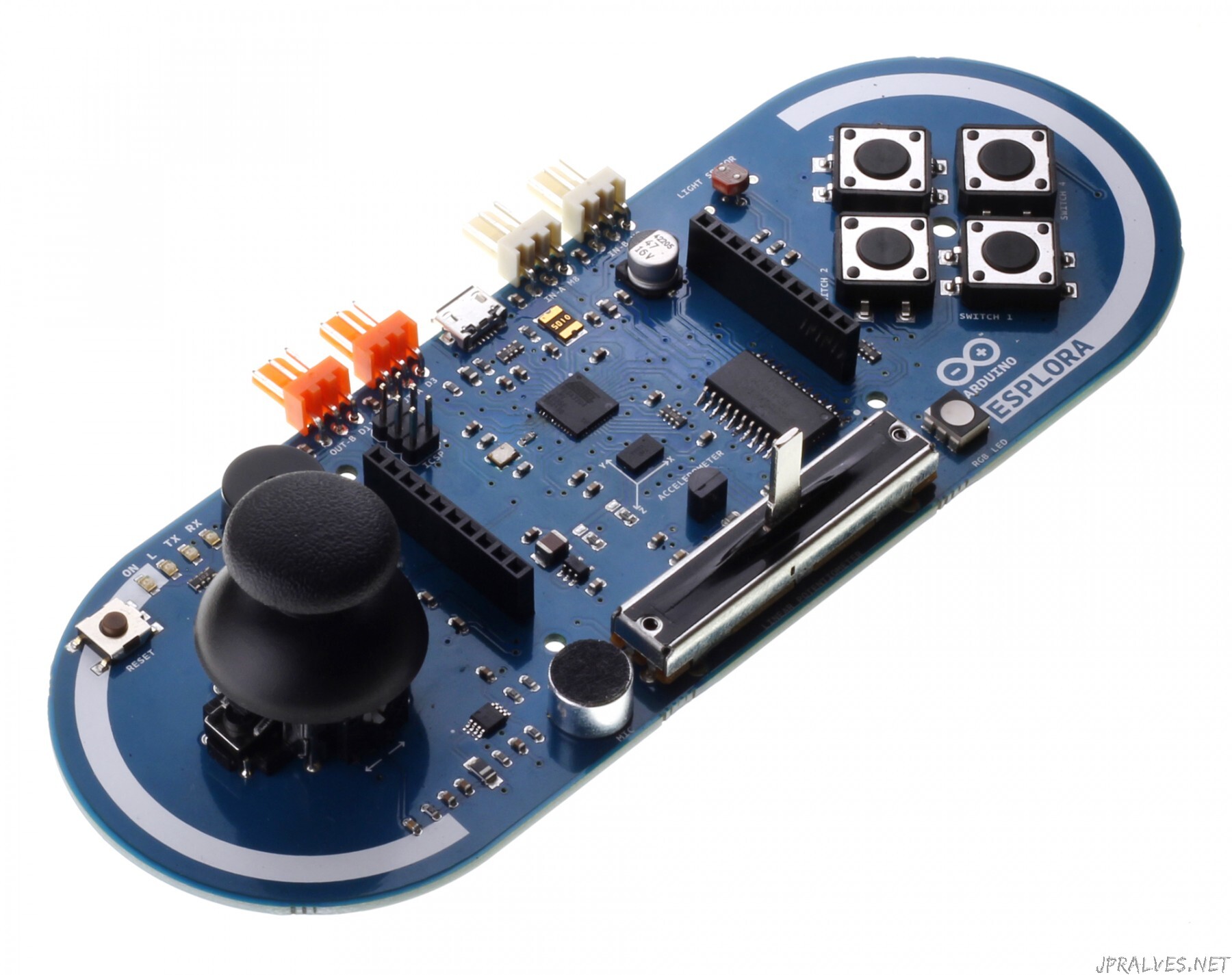
The Arduino Esplora is a microcontroller board derived from the Arduino Leonardo. The Esplora differs from all preceding Arduino boards in that it provides a number of built-in, ready-to-use set of onboard sensors for interaction. It’s designed for people who want to get up and running with Arduino without having to learn about the electronics first.
The Esplora has onboard sound and light outputs, and several input sensors, including a joystick, a slider, a temperature sensor, an accelerometer, a microphone, and a light sensor. It also has the potential to expand its capabilities with two Tinkerkit input and output connectors, and a socket for a color TFT LCD screen.
Specifications
- Microcontroller: ATmega32u4
- Operating Voltage: 5V
- Flash Memory: 32 KB of which 4 KB used by bootloader
- SRAM: 2.5 KB
- EEPROM: 1 KB
- Clock Speed: 16 MHz
- Lenght: 164.04 mm
- Width: 60 mm
- Weight: 53g
PinOut


Arduino UNO Mini Limited Edition
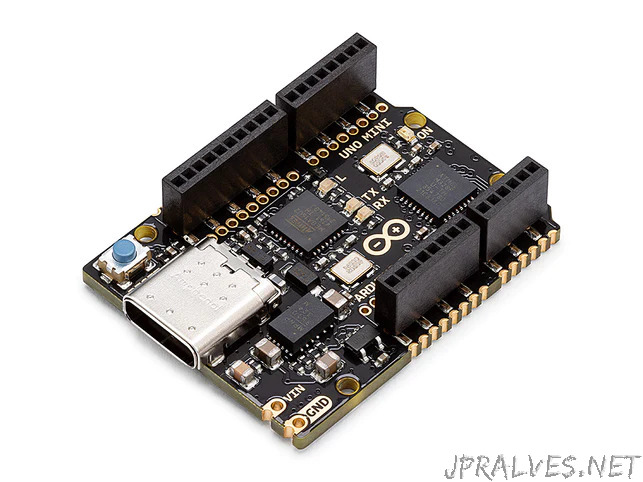
The Arduino UNO Mini LE is a microcontroller board based on the ATmega328P (datasheet). It has 14 digital inputs/outputs (six of which can be used as PWM outputs), six analog inputs, a 16MHz ceramic resonator, a USB-C connector, and a reset button. Contains everything needed to support the microcontroller. Simply connect it to a computer with a USB cable, use a power adapter, or connect a battery to get started.
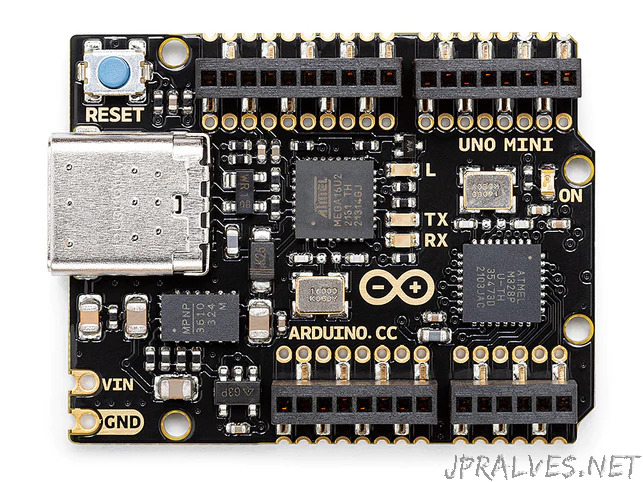
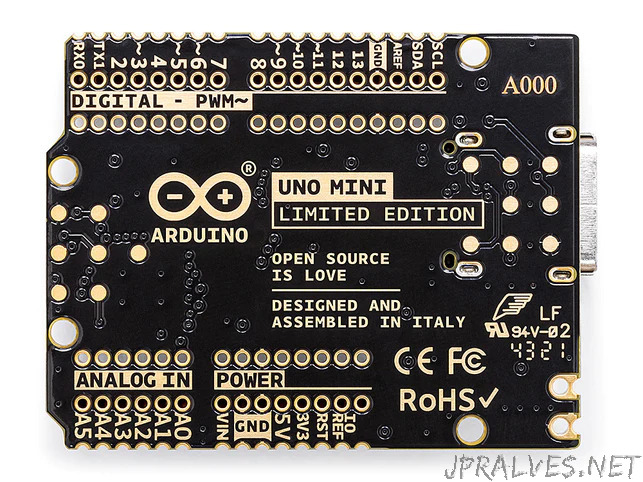
Specifications
- Microcontroller: ATmega328P
- USB Connector: USB-C
- Built-In LED PIN: 13
- Digital I/O Pins: 14
- Analog Input Pins: 6
- PWM Pins: 6
- UART: yes
- I2C: yes
- SPI: yes
- Circuit Operating Voltage: 5V
- Input Voltage (Limit): 6-12V
- DC Current Per I/O Pin: 20 mA
- DC Current For 3.3V Pin: 50 mA
- Main Processor: ATmega328P 16 MHz
- USB-Serial Processor: ATmega16U2 16 MHz
- Memory Atmega328P: 2KB SRAM, 32KB FLASH, 1KB EEPROM
- Length: 34.20 mm
- Width: 26.70 mm
- Weight: 8.05g
PinOut
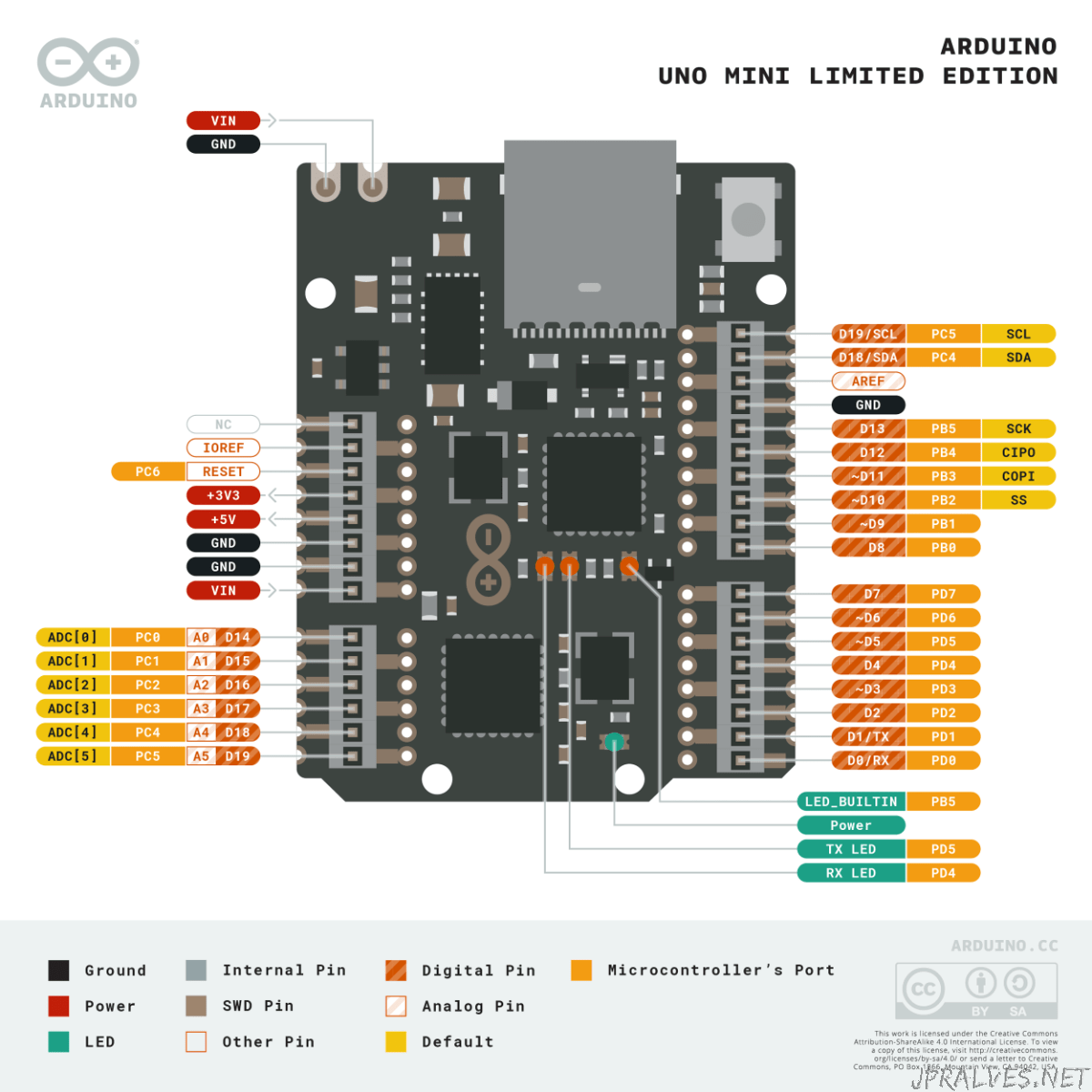
Dimensions

Arduino Uni R4 Wifi
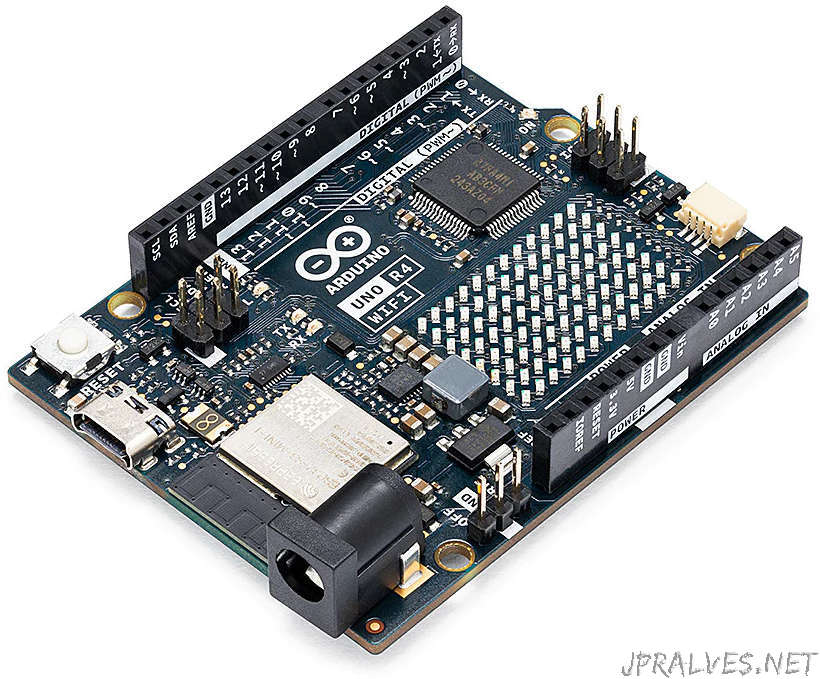
The Arduino UNO R4 WiFi merges the RA4M1 microprocessor from Renesas with the ESP32-S3 from Espressif, creating an all-in-one tool for makers with enhanced processing power and a diverse array of new peripherals. With its built-in Wi-Fi® and Bluetooth® capabilities, the UNO R4 WiFi enables makers to venture into boundless creative possibilities. Furthermore, this versatile board boasts a convenient on-board 12x8 LED matrix and a Qwiic connector, offering ample space for innovation and unleashing creativity. This dynamic combination empowers makers to transform their ideas into reality and elevate their projects to unprecedented heights.
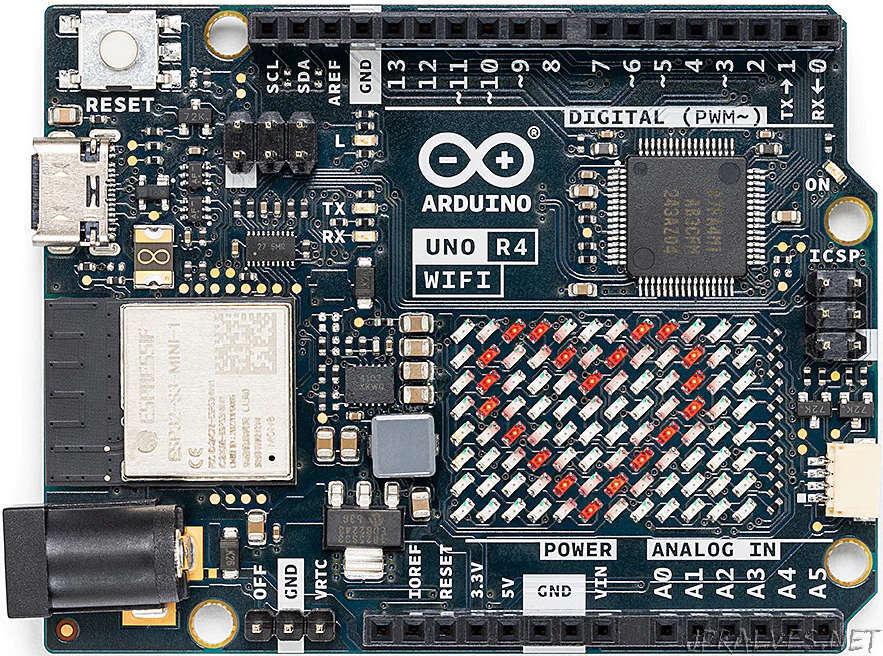
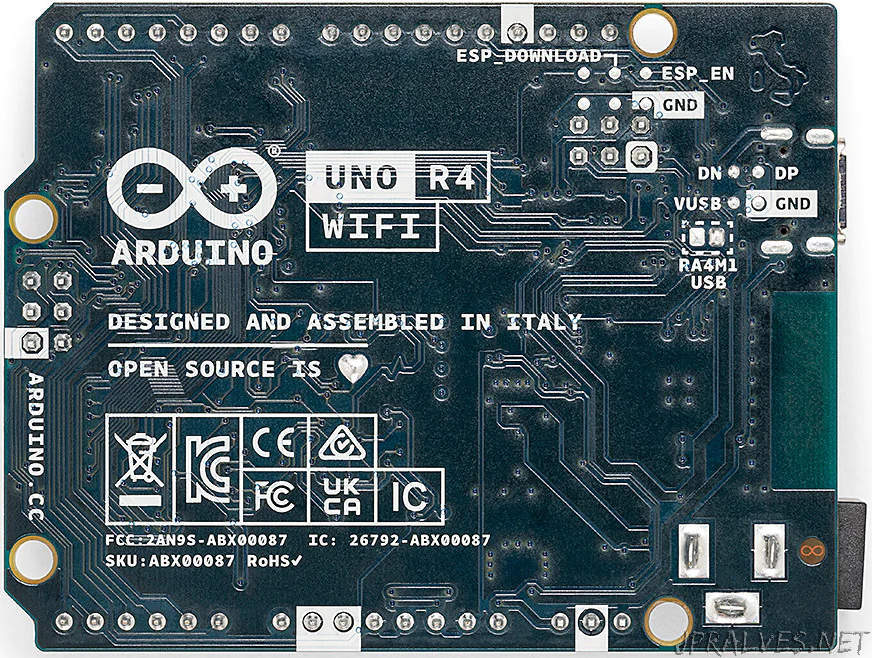
Specifications
- Microcontroller: Renesas RA4M1 (Arm® Cortex®-M4)
- USB Connector: USB-C
- Digital I/O Pins: 14
- Analog Input Pins: 6
- DAC Pins: 1
- PWM Pins: 6
- UART: yes
- I2C: yes
- SPI: yes
- CAN: yes
- Circuit Operating Voltage: 5V (ESP32-S3 is 3.3 V)
- Input Voltage (Limit): 6-24V
- DC Current Per I/O Pin: 8 mA
- DC Current For 3.3V Pin: 50 mA
- Main Processor: RA4M1 48 MHz
- WIFI Processor: ESP32-S3 up to 240 MHz
- Memory RA4M1: 256 kB Flash, 32 kB RAM
Memory ESP32-S3: 384 kB ROM, 512 kB SRAM
Length: 53.34 mm
- Width: 68.85 mm
- Weight: 30 g
PinOut

Dimensions
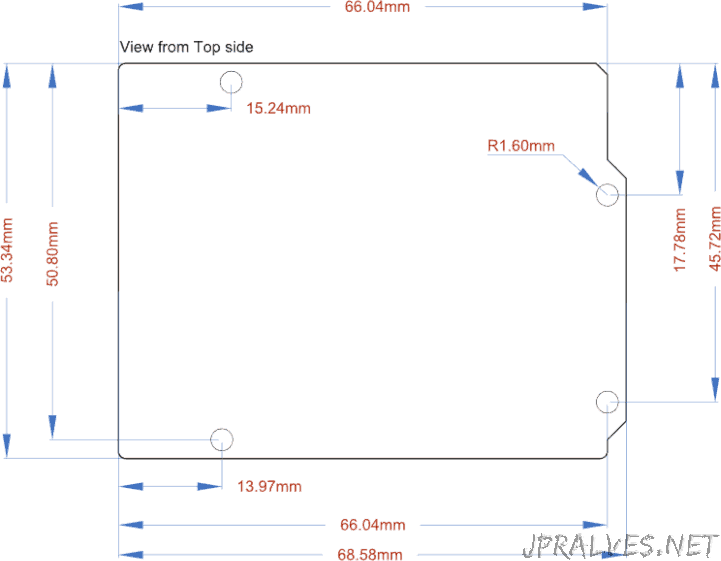
Arduino Nano RP2040 Connect
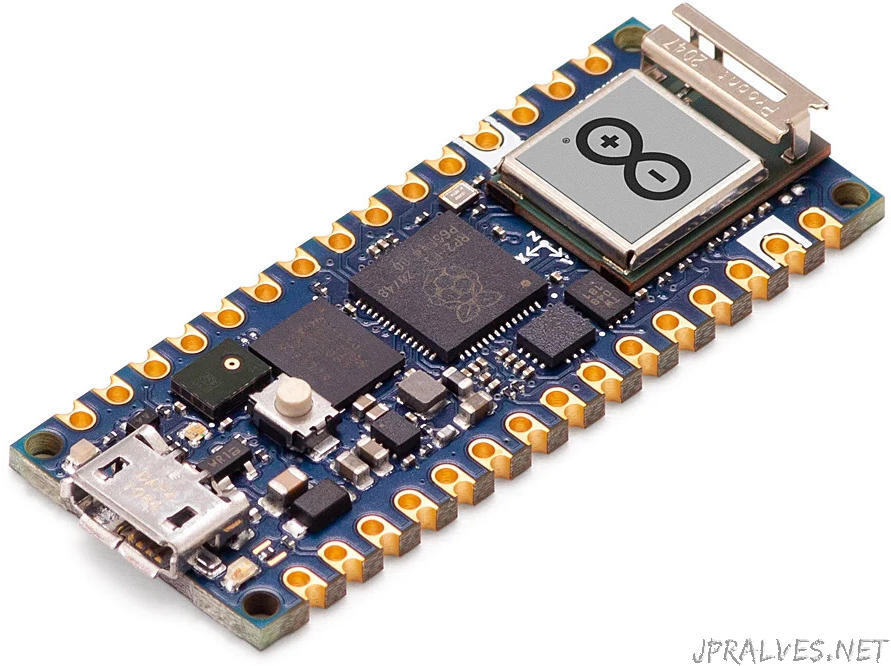
The Arduino Nano RP2040 Connect is the feature packed Arduino Nano board built with Raspberry Pi’s new silicon.
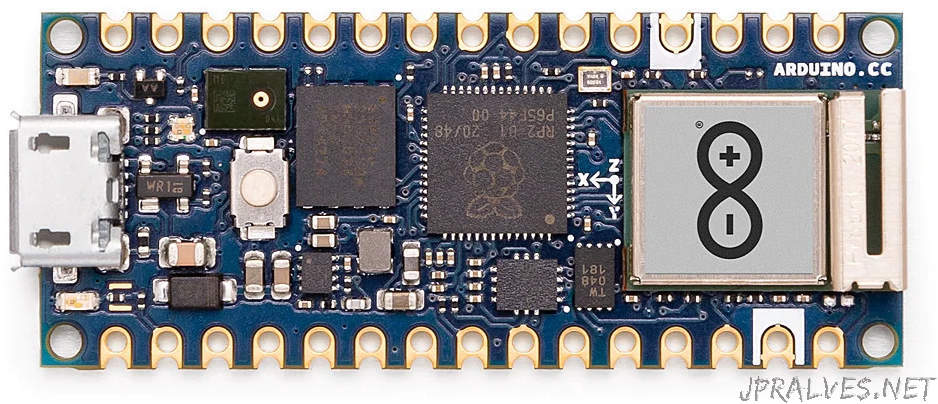
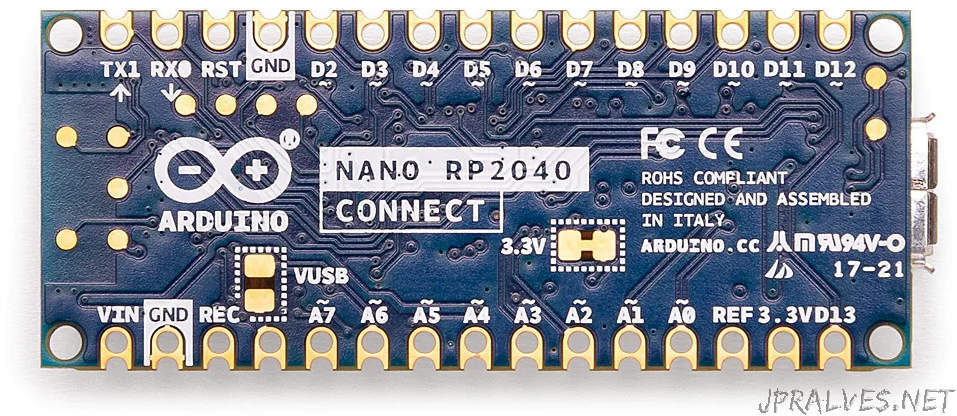
Specifications
- Microcontroller: Raspberry Pi RP2040
- USB Connector: Micro USB
- Built-in LED Pin: 13
- Digital I/O Pins: 22
- Analog Input Pins: 8
- PWM Pins: 20
- External Interrupts: 20
- UART: yes
- I2C: yes
- SPI: yes
- CAN: yes
- Circuit Operating Voltage: 3.3V
- Input Voltage (Limit): 5-18V
- DC Current Per I/O Pin: 12 mA
- Main Processor: RP2040 133 MHz
- WIFI Processor: Nina W102 uBlox up to 240 MHz
- Memory RA4M1: 16 MB Flash, 264 kB RAM
Memory Nina W102 uBlox: 448 KB ROM, 520KB SRAM, 2MB Flash
Length: 45 mm
- Width: 18 mm
- Weight: 6 g
PinOut
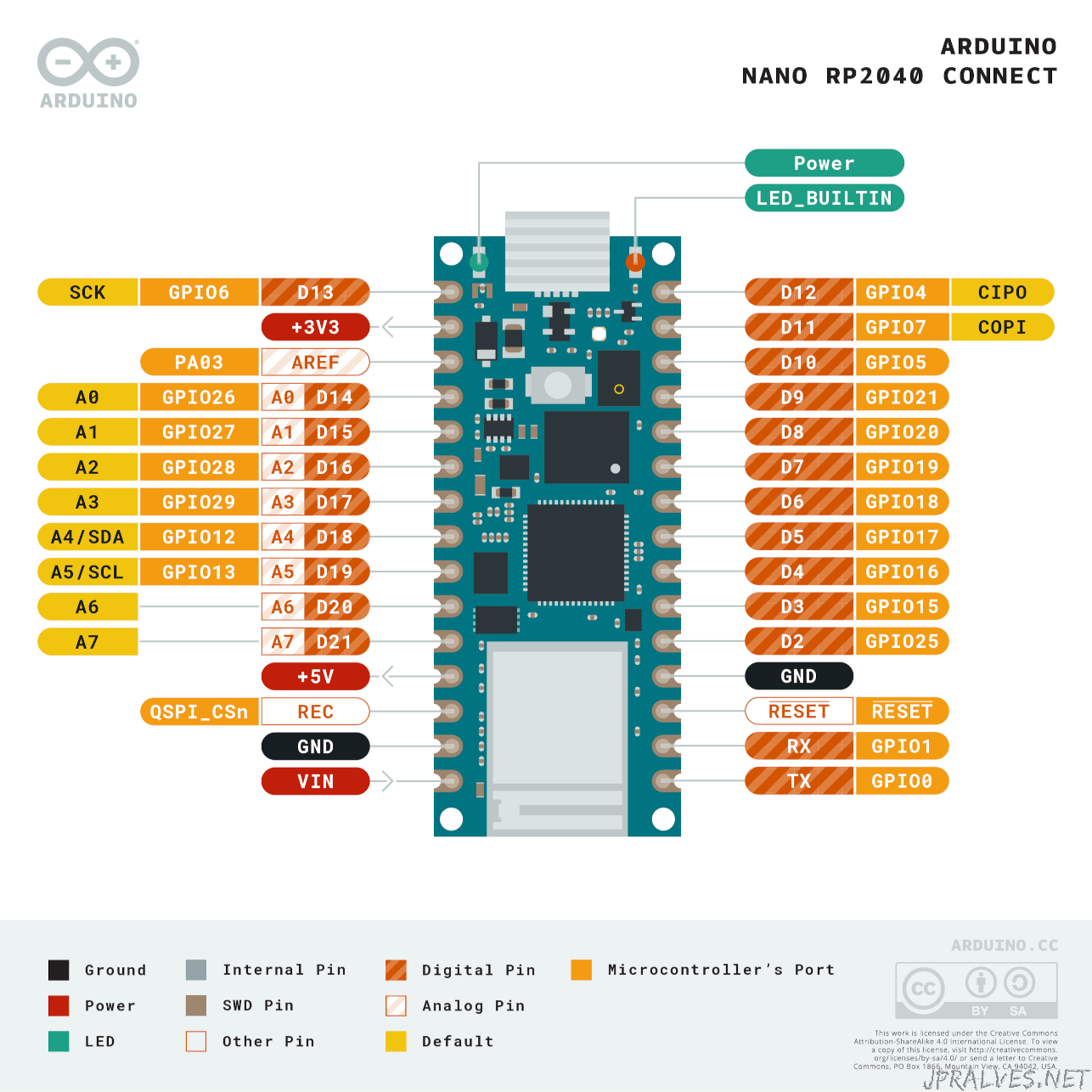
Dimensions
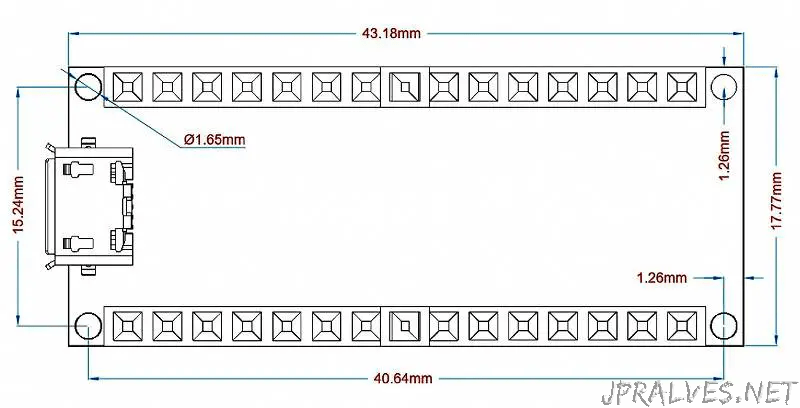
CSEduino v4
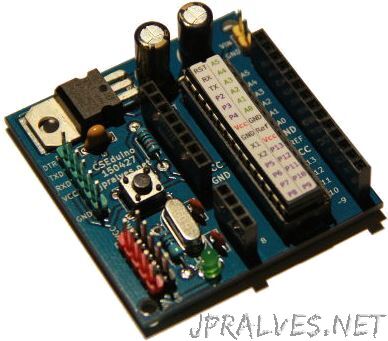
The CSEduino is the answer to a very low cost DIY Arduino like board. The CSE stands for Cheap, Small and Easy to build. With a very small budget of up to € 3.5 (5 USD) in parts it is possible to build this board with the required components. To be small some optimizations were made to the stripboard to accomplish its reduced size. The board is 4.5cm x 5.5cm. The circuit is adaptable to different requirements and it was made modular enough to be able remove the parts not needed and reduce its size even further. To be simple and easy to build I’ve used only THT - Through-hole technology. Avoiding SMD - Surface Mount Devices - components - as they are harder to solder and prone to errors. I’ve used the most common microcontroller used in Arduino Boards with THT - the ATMega328P (in PDIP format).
PinOut
